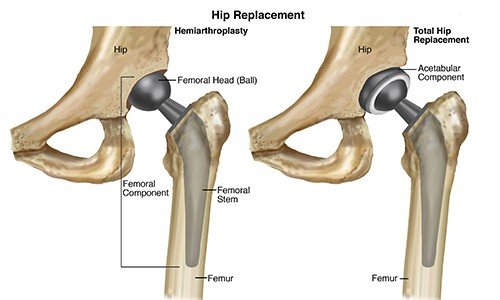Hip replacement surgery is a life-changing procedure for individuals suffering from chronic hip pain, joint deterioration, or injuries that severely impact mobility and quality of life. While the goal of both total and partial hip replacements is to relieve pain and restore function, the extent of the procedure and the conditions they treat differ significantly. In this blog, we’ll explore both procedures in depth, their indications, differences, recovery expectations, and how to choose the right option.
Understanding the Hip Joint
The hip is a ball-and-socket joint where the femoral head (the ball at the top of your thighbone) fits into the acetabulum (the socket in your pelvis). This joint allows for smooth movement and weight-bearing activities. Over time or due to trauma, the cartilage in the hip can wear down, leading to inflammation, stiffness, and severe pain.
What Is a Total Hip Replacement (THR)?
A Total Hip Replacement—also called Total Hip Arthroplasty—involves replacing both components of the hip joint:
- The femoral head (ball) is replaced with a metal or ceramic ball attached to a stem, which is inserted into the femur.
- The acetabulum (socket) is replaced with a metal cup, often lined with plastic, ceramic, or metal.
Who Is It For?
Total hip replacement is typically recommended for:
- Patients with advanced osteoarthritis, rheumatoid arthritis, or avascular necrosis
- Individuals with extensive joint damage
- People experiencing severe pain not relieved by conservative treatments
- Those with functional limitations affecting daily life
What Is a Partial Hip Replacement (PHR)?
A Partial Hip Replacement—also known as hemiarthroplasty—involves replacing only the femoral head. The socket (acetabulum) remains intact if it’s healthy and undamaged.
Who Is It For?
Partial hip replacement is usually recommended for:
- Elderly patients with a fracture of the femoral neck
- Those with minimal damage to the hip socket
- Individuals who may not tolerate a more extensive surgery
Key Differences at a Glance
| Feature | Total Hip Replacement (THR) | Partial Hip Replacement (PHR) |
| Replaces | Both ball and socket | Only the ball (femoral head) |
| Commonly Used For | Arthritis, degeneration | Fractures in elderly patients |
| Surgical Complexity | More complex | Less complex |
| Longevity | Often longer-lasting | May wear faster |
| Mobility Improvement | Higher | Moderate |
| Recovery Time | Longer | Shorter |
Recovery and Rehabilitation
Total Hip Replacement
- Typically requires a 2–5 day hospital stay
- Physical therapy begins within 24 hours post-surgery
- Recovery period: 3 to 6 months
- Gradual return to full weight-bearing
- Long-term outcome: excellent pain relief and improved mobility
Partial Hip Replacement
- Often a shorter hospital stay (1–3 days)
- Faster recovery due to less joint involvement
- Still requires rehabilitation and mobility exercises
- More suitable for low-activity patients or frail individuals
Which One Should You Choose?
The right choice depends on:
- Age and activity level
- Extent of joint damage
- Bone health and density
- Presence of arthritis or other joint diseases
- Your surgeon’s assessment and recommendations
Total hip replacement is usually better for younger or active individuals with widespread joint damage, while partial hip replacement works well for older adults with localized injury and healthy sockets.
Risks and Complications
Both procedures have risks such as:
- Infection
- Blood clots
- Joint dislocation
- Implant loosening
- Leg length differences
With skilled surgery and proper post-op care, these complications are rare.
Conclusion
Both total and partial hip replacements are effective solutions for restoring mobility and relieving chronic pain. Total hip replacement is comprehensive and better suited for long-term joint health, while partial hip replacement is ideal for specific cases like fractures in elderly individuals. Consulting an orthopaedic surgeon is the best way to determine the most suitable treatment for your condition.
Disclaimer: This blog is for informational purposes only and does not substitute professional medical advice. Always consult a licensed healthcare provider for diagnosis and treatment options tailored to your health condition.
